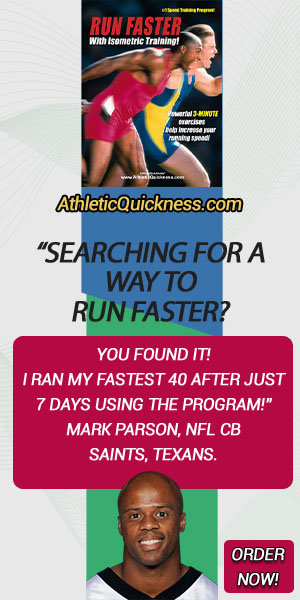Physiological Effects of Strenuous Exercise
Part 1: Muscle Tissue and Contractions
Part 2: Types of Muscles
Part 3: Fast Twitch and Slow Twitch Muscles
Part 4: Physiological Effects of Strenuous Exercise
Most of the exercises people find themselves in the gym or out on a track or field involve routines that put their muscles through concentric contractions (muscle tension during shortening) or eccentric contractions (muscle tension during lengthening).
Exercises in the gym that fit these descriptions are most of your dumbbell exercises such as bicep curls, shoulder presses, and chest presses along with other routines such as rows, squats and leg extensions.
Exercises away from the gym would include most of your running sports or drills along with any jumping routines such as those done during plyometric box jumps or perhaps the field events such as the long jump and high jump.
All of these exercises and more have value to an athlete. No training routine would be complete without at least involving some of them.
So what effect do the many commonly performed exercises have on your body and in particular, on your muscles?
The primary goal of most exercises is to build strength within the muscle. If workouts are performed for say 30 minutes or more, endurance within your muscles and body also increase with those specific exercises or movements.
How then does this occur?
When muscles undergo tension, either by contracting or lengthening, the resultant effect on the muscle is first to open up the blood supply to these muscles providing them with the much needed oxygen and nutrients.
Repetitively performing exercises on your muscles will ultimately stimulate growth in the cells known as hypertrophy, which means, to get bigger.
[sc name=”2-stepoptin-blue”]
Hyperplasia, another term used to define a change in an organ or tissue, is a general term referring to the proliferation of cells beyond that which is normally seen, such as in the case of a tumor. Hyperplasia doesn’t occur with exercise.
When muscles hypertrophy, the most common physiological changes that take place within the muscle are an increased number of mitochondria formation and an increased number of capillary formation per cross section. The mitochondria are the energy storehouses of the cells and it stands to reason that when you get stronger in doing a certain exercise, the mitochondria would naturally have to increase to accommodate this change.
Likewise, with the increase in size of the muscles cells, more and more oxygen and nutrients will be required to support this new development and the capillaries, which are responsible for transmitting them, would naturally have to increase to service the cell.
These two main changes, increased numbers of mitochondria and increased numbers of capillary formation, are common with increasing muscle size.
Is that a good thing? Sure it is.
Larger muscles always look more attractive on an individual than smaller ones and muscular strength typically adds to your confidence as well as to the much desired athletic performance.
With all positive changes however, there’s always the potential for negative ones to go along with them.
In the example above, regarding the physiological changes in the mitochondria and capillaries, you may remember that high numbers of these two found within a cell are characteristics of Type I fibers, or slow twitch fibers. Type IIb fibers, fast twitch fibers, typically have lower numbers of them.
Does that mean that when your muscles get big that your fast twitch fibers are changing to slow twitch fibers? No.
As of the writing of this article, this has not been proven. However what has been proven is that by overdeveloping your muscles, especially the ones containing high amounts of Type IIb fast twitch fibers, you create within the fast twitch fibers characteristics of slow twitch fibers.
As a result the fast twitch fibers in these muscles begin to behave a little more like slow fibers and may not perform up to their potential for fast contractions.
[sc name=”2step-optin”]
If, when you exercise, your goal is to build strength and endurance, then this wouldn’t be seen as a problem. However if, when you exercise, your goal is to build speed and quickness, then you might find yourself struggling against the very laws of nature that prevent you from achieving this goal.
With all things there needs to be a proper balance for everything, including your athletic performance, to work at maximum efficiency. Performing concentric and eccentric exercises are necessary and needed to form a solid strength foundation in which to develop your athletic skills.
Sometimes these types of exercises translate into your being able to get faster and perform with greater endurance. Other times however, your strength and endurance improve, but your speed ends up dropping.
We haven’t mentioned too much about isometric training yet, but now is the time. Isometric training, where the resistance band is used instead of weights for the resistance aid, is a unique training strategy that enables your muscles to get stronger and faster with very little or no hypertrophy, providing that you don’t engage in this activity for longer than 15 or 20 minutes a day.

Figure 6. Example of an isometric contraction using the resistance band.
Unlike weights, the resistance band offers hyper-elastic resistance forces that change the amount of tension being supplied back into your muscles with even the slightest of movements. You can learn more about how the bands with isometrics increases your speed here. (Resistance Bands For Speed Training).
Since your muscles typically won’t hypertrophy with this technique, the strength and coordination you develop within your muscles won’t be offset by any additional body weight that is quite common with most other strenuous exercise routines.
By limiting the training time to a few minutes the Type IIb fast twitch fibers are conditioned for their natural ability to contract quickly.
Including isometric training exercises with the resistance band into your current training routine will complete the three different types of muscle contractions your body needs to excel:
1) isometric contractions
2) concentric contractions and
3) eccentric contractions.
The results will be seen in more complete development of your athletic skills and improved overall athletic performance. Whether you are trying to make the team, get off the bench, standout from the crowd, or advance your athletic career – adding isometrics with the resistance band to your workout routine for increased muscle speed may by your key to success.
Part 1: Muscle Tissue and Contractions
Part 2: Types of Muscles
Part 3: Fast Twitch and Slow Twitch Muscles
Part 4: Physiological Effects of Strenuous Exercise
[sc name=”tennis testimonial banner – green”]
[sc name=”Order Here Button-01″]






